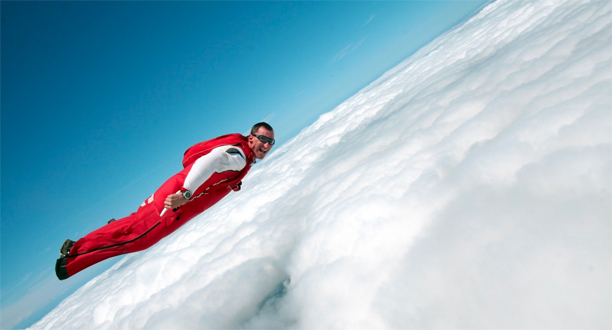James Cameron’s Risky Business

National Geographic Explorer-in-Residence James Cameron is solo-piloting a sub to the ocean’s deepest point to collect never before possible footage and samples for science. He’s also taking what many may think is an enormous risk. Read below for insights as to why and read more about the expedition risks and dangers here.
“There are a thousand ways to die on this project—it makes your BASE jumping look positively safe,” said John Garvin. I replied, “Either you don’t know how dangerous BASE jumping is, or this is one of the most extreme undertakings in the history of risk.” In retrospect, both statements are true.
John Garvin is head of the sub internal team of the DEEPSEA CHALLENGE expedition. His job constitutes what is, essentially, a Herculean task: to ensure that all systems inside a uniquely designed submersible run smoothly under extremely hostile conditions. The systems for which he is responsible include the very systems that keep the sub’s solo pilot, James Cameron, alive. In order to do his job effectively, John must not only understand how to make these systems work under optimal conditions, he must also understand each and every risk that could jeopardize their functionality and, in turn, the pilot’s life. He wanted advice.
“List out the risks that could lead to injury or fatality on a deep-ocean expedition,” I suggested, and we dove in. The list of risks that the pilot of the DEEPSEA CHALLENGER sub faces is long and, quite frankly, very intimidating. For more information about specific risks that the DEEPSEA CHALLENGER sub is designed to withstand, visit this link. The engineering required to anticipate and accommodate these risks is so complicated that it has been likened to the task of putting men on the moon. There is great value in facilitating manned exploration of the deep oceans—but listening to John outline each and every risk these explorers would face raised the question, Why would anyone volunteer to do this?
Psychologists, neuroscientists, economists, and others are fascinated by the fact that some people more than others are open to—even driven by—opportunities involving risk. Some call this behavior “risk loving” as opposed to “risk averse,” but the circumstances that make people behave in one way more than another are poorly understood. Professor Marvin Zuckerman of the University of Delaware suggests that genetic conditions, likely mitigated or triggered by environmental factors, may play a role in how some people handle risk.
In his 1994 book, Behavioral Expressions and Biosocial Bases of Sensation Seeking, Zuckerman explains the development of his “Sensation Seeking Scale,” a scale that measures four different behavioral traits: thrill and adventure seeking, experience seeking, disinhibition, and boredom susceptibility. An individual’s score on this scale is a measure of an individual’s likelihood to engage in risky behavior.
The pursuit of such risky behavior may be linked to the D4DR gene on chromosome 11. The D4DR gene, or “thrill gene” as it is often called, codes for a receptor in the brain that is sensitive to a neurotransmitter called dopamine. Dopamine signals action and elation in our brains—it is released whenever we feel good about something. High-sensation seekers tend to have weaker dopamine receptors, i.e., they need more sensory stimulation to enjoy the feel-good effect of dopamine. They tend to be the explorers, adventurers, and extroverts in our society.
High-sensation seekers and low-sensation seekers may have trouble empathizing with each other, as their neurochemical reactions to comparable situations are likely very different. Perhaps this is why parents everywhere simply cannot understand why some children, let alone their own, would want to jump out of a perfectly good aircraft, ride a motorcycle, or pilot a submersible to the bottom of the ocean. And who, among us, can blame them?
But there is an important role for high-sensation seekers to play in our world of constant change and advancement. There are many activities that incur great risk for a few but promise potential gains for many. Doctors rely upon medical trials to improve treatment options available to patients. The Wright brothers piloted an airplane that paved the way for a world of global connectivity that they could never have imagined. Some risks are incurred out of necessity for lack of other options, and others are sought out by choice.
Why would Jim, someone with so much to do and so much at risk, pilot a prototype submersible to the most inhospitable and extreme environment on the planet? I asked him. He responded with a passionate discourse about the potential scientific benefits of the expedition and the importance of jumpstarting renewed emphasis on oceanic research and exploration. I waited until he finished speaking before prodding him about his personal motivations. Jim looked at me and said, “Well, Glenn, if anyone can understand this, it’s you. How do you explain your mountaineering and BASE jumping?” And he was right. I have been inspired by, and eager to become involved with, the DEEPSEA CHALLENGE expedition since first hearing about it. Like Jim, I am attracted to the thrill of an intellectually and physically stimulating challenge, the task of building a solution from scratch to push back the boundaries of the known world.
“Are you worried?” I asked.
“Yes, of course,” Jim responded. “Worry is a good thing when you’re an explorer. It’s when you’re cavalier, when you take risk for granted, that’s when you’re gonna get bit.”
About the Author:
Dr. Glenn Singleman and his wife, Heather, hold the world record for the highest wingsuit BASE jump from Mount Meru at 21,666.6 (6604 meters) in the Garwhal Himalaya of India. Singleman has also climbed mountains around the world, sailed to Antarctica, and visited the Titanic in the Mir 1 submersible.
Sensation Seeking Scale
Curious about your own level of thrill seeking? Determine your own level of risk aversion or seeking by taking Professor Martin Zuckerman’s 40 question thrill-seeking questionnaire. It takes an estimated 15 minutes to complete and was first published in 1971.



